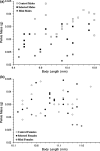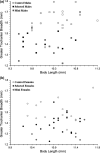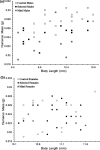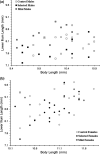Rapid and longer-term effects of selective breeding for voluntary exercise behavior on skeletal morphology in house mice
- PMID: 33089524
- PMCID: PMC7855075
- DOI: 10.1111/joa.13341
Rapid and longer-term effects of selective breeding for voluntary exercise behavior on skeletal morphology in house mice
Abstract
Selection experiments can elucidate the varying course of adaptive changes across generations. We examined the appendicular skeleton of house mice from four replicate High Runner (HR) lines bred for physical activity on wheels and four non-selected Control (C) lines. HR mice reached apparent selection limits between generations 17 and 27, running ~3-fold more than C. Studies at generations 11, 16, and 21 found that HR mice had evolved thicker hindlimb bones, heavier feet, and larger articular surface areas of the knee and hip joint. Based on biomechanical theory, any or all of these evolved differences may be beneficial for endurance running. Here, we studied mice from generation 68, plus a limited sample from generation 58, to test whether the skeleton continued to evolve after selection limits were reached. Contrary to our expectations, we found few differences between HR and C mice for these later generations, and some of the differences in bone dimensions identified in earlier generations were no longer statistically significant. We hypothesize that the loss of apparently coadapted lower-level traits reflects (1) deterioration related to a gradual increase in inbreeding and/or (2) additional adaptive changes that replace the functional benefits of some skeletal changes.
Keywords: adaptation; artificial selection; behavior; bone; coadaptation; experimental evolution; locomotion.
© 2020 Anatomical Society.
Figures







Similar articles
-
Evolution of hindlimb bone dimensions and muscle masses in house mice selectively bred for high voluntary wheel-running behavior.J Morphol. 2018 Jun;279(6):766-779. doi: 10.1002/jmor.20809. Epub 2018 Mar 13. J Morphol. 2018. PMID: 29533474
-
Effects of long-term voluntary wheel running and selective breeding for wheel running on femoral nutrient canals.J Anat. 2024 Jun;244(6):1015-1029. doi: 10.1111/joa.14021. Epub 2024 Feb 2. J Anat. 2024. PMID: 38303650
-
Effects of selective breeding for voluntary exercise, chronic exercise, and their interaction on muscle attachment site morphology in house mice.J Anat. 2022 Feb;240(2):279-295. doi: 10.1111/joa.13547. Epub 2021 Sep 14. J Anat. 2022. PMID: 34519035 Free PMC article.
-
Hormones and the Evolution of Complex Traits: Insights from Artificial Selection on Behavior.Integr Comp Biol. 2016 Aug;56(2):207-24. doi: 10.1093/icb/icw040. Epub 2016 Jun 1. Integr Comp Biol. 2016. PMID: 27252193 Free PMC article. Review.
-
Phenotypic plasticity and experimental evolution.J Exp Biol. 2006 Jun;209(Pt 12):2344-61. doi: 10.1242/jeb.02244. J Exp Biol. 2006. PMID: 16731811 Review.
Cited by
-
Multiple solutions at the genomic level in response to selective breeding for high locomotor activity.Genetics. 2023 Jan 12;223(1):iyac165. doi: 10.1093/genetics/iyac165. Genetics. 2023. PMID: 36305689 Free PMC article.
-
Large changes in detected selection signatures after a selection limit in mice bred for voluntary wheel-running behavior.PLoS One. 2024 Aug 1;19(8):e0306397. doi: 10.1371/journal.pone.0306397. eCollection 2024. PLoS One. 2024. PMID: 39088483 Free PMC article.
-
Early-life exercise effects on Achilles tendon in mice selectively bred for high voluntary wheel-running behavior.Physiol Rep. 2025 Aug;13(16):e70515. doi: 10.14814/phy2.70515. Physiol Rep. 2025. PMID: 40827110 Free PMC article.
-
Early-life effects of juvenile Western diet and exercise on adult gut microbiome composition in mice.J Exp Biol. 2021 Feb 25;224(Pt 4):jeb239699. doi: 10.1242/jeb.239699. J Exp Biol. 2021. PMID: 33431595 Free PMC article.
-
Sex-specific aging in animals: Perspective and future directions.Aging Cell. 2022 Feb;21(2):e13542. doi: 10.1111/acel.13542. Epub 2022 Jan 23. Aging Cell. 2022. PMID: 35072344 Free PMC article. Review.
References
-
- Bilodeau, G.M. , Guderley, H. , Joanisse, D.R. & Garland Jr., T. (2009) Reduction of type IIb myosin and IIB fibers in tibialis anterior muscle of mini‐muscle mice from high‐activity lines. Journal of Experimental Zoology Part A: Ecological Genetics and Physiology, 311A, 189–198. 10.1002/jez.518 - DOI - PubMed
Publication types
MeSH terms
LinkOut - more resources
Full Text Sources

